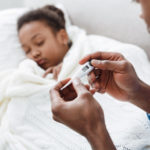What to expect from cold and flu season this year

At least fewer people came down with colds and flu in 2020: That’s one of the few positive things we can say about the year of widespread social distancing. Rates of influenza and several other viral infections were historically low, and even the common cold seemed to take the year off from making kids and parents miserable.
With more kids returning to school this fall, many parents and experts worry that colds and flu, which spread in many of the same ways as COVID-19, will make a comeback. The U.S. Centers for Disease Control and Prevention recently alerted pediatricians that respiratory viruses could return to pre-pandemic levels.
RSV infections climbed over the summer. Will colds and flu follow?
Like many viral infections, respiratory syncytial virus (RSV) infections hit an all-time low between April 2020 and April 2021. But starting in May, children’s hospitals around the U.S. saw an uptick in RSV cases that continued through the summer. The timing was puzzling.
What is RSV?
RSV is a common respiratory virus that usually causes mild symptoms. However, in infants and children under 5, RSV infection can lead to severe illness and hospitalization.
“Typically, we see cases of RSV rise in the fall and winter,” says Dr. Melanie Dubois, a pediatric infectious disease specialist at Boston Children’s Hospital. Seemingly, COVID-19 prevention measures interrupted normal RSV transmission. But RSV came back as soon as relaxed mask mandates and less social distancing gave it an opening.
This year’s cold and flu season is also hard to predict. Typically, public health officials look at infection trends from the previous year to forecast what will happen in the year ahead. Last year’s dip in cases has thrown this method off track. Nonetheless, there are several reasons to believe respiratory infections could return with a vengeance:
- More kids are returning to school. While remote learning took a heavy toll on students and parents, it proved remarkably effective in reducing colds and flu. “Teachers, students, and parents need to remain vigilant this fall,” says Dr. Dubois.
- Many communities relaxed COVID-19-prevention measures. The severity of this year’s cold and flu season could depend in part on whether communities continue taking precautions against COVID-19.
- More people are traveling. Travelers have had to wear masks on airplanes since early in the pandemic and will continue having to do so until January 2022 at least. But even if viruses are less likely to circulate on planes, a trip to another state or region gives them plenty of opportunities to get around.
- Our immune systems may have let down their guard. “The rise in RSV cases this summer may be partially due to the fact that fewer infants and toddlers were exposed to the virus during the pandemic,” says Dr. Dubois. Fighting infection keeps your immune system on its toes. After a year off, many people’s immune systems may be less prepared to ward off new infection.
How to protect your child (and yourself) from respiratory infections this fall
Flu: “We see children hospitalized with severe flu symptoms every year,” says Dr. Dubois. Because of this, she stresses the importance of getting yourself and your children vaccinated against the flu every fall. The flu vaccine is recommended for any child older than 6 months.
RSV: Like the flu, RSV is responsible for many childhood hospitalizations, particularly among infants. “There’s no RSV vaccine at this time, but there is a monoclonal antibody available for high-risk infants that parents can discuss with their pediatrician.” If your child is having trouble breathing, appears lethargic, or is not feeding or drinking well, call your pediatrician. Dr. Dubois also recommends frequent handwashing and keeping your child at home when they feel sick.
Colds: The common cold typically does not become serious enough to require hospitalization, but nobody wants to catch a cold if they can avoid it. The best way to ward off colds probably sounds familiar: enforcing frequent handwashing and if your child feels sick, minimizing their contact with others.
Preventing colds, flu, and COVID-19
Protecting yourself and your family from flu, RSV, and other viruses in many ways goes hand in hand with preventing the spread of COVID-19. “Given the spread of the Delta variant in the U.S., we will likely continue to see COVID-19 prevention measures in indoor places,” says Dr. Dubois. “This could also play a role in limiting transmission of other viruses.”
One of the best things you can do to protect your family from COVID-19 is ensure that all eligible adults and children over age 12 in your household get vaccinated. And because it’s often difficult to distinguish COVID-19 from other viral infections, if anyone in your family member has cold symptoms, arrange to have them tested for COVID-19.
Learn more about the Division of Infectious Disease and Boston Children’s response to COVID-19.
Related Posts :
-

Five things to know about the flu
It’s flu season again. In fact, about half of every year, from September to March, is “flu season.” Despite ...
-

Why parents really need to talk to their children about the news
These are strange, anxiety-provoking times. That’s true no matter where one lives or where one sits on the political ...
-

Five ways to help manage your child’s asthma this school year
While fall is a time of considerable change for children — a new school year with new challenges — it can also ...
-

Nanobodies from alpacas could steer immune attacks on influenza
While conventional flu vaccines are designed to anticipate the influenza strains projected to dominate in the next flu season, they’...





